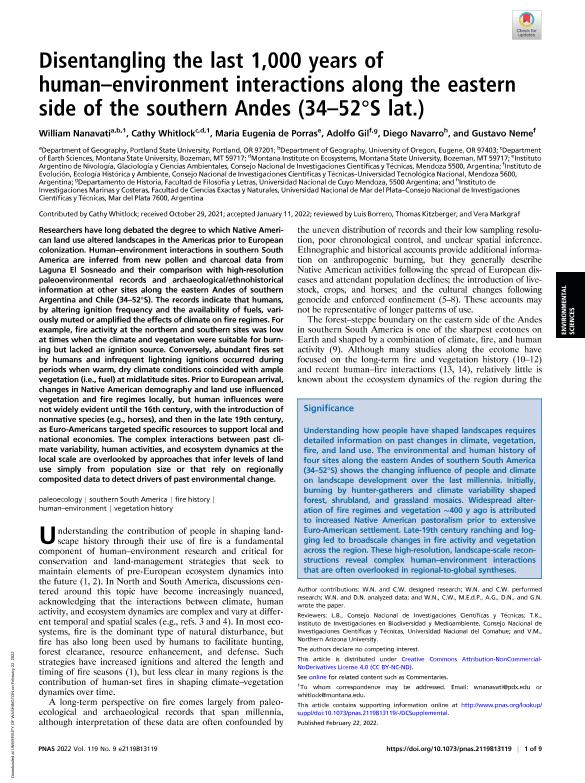Mostrar el registro sencillo del ítem
dc.contributor.author
Nanavati, William

dc.contributor.author
Whitlock, Cathy

dc.contributor.author
de Porras, Maria Eugenia

dc.contributor.author
Gil, Adolfo Fabian

dc.contributor.author
Navarro, Diego

dc.contributor.author
Neme, Gustavo Adolfo

dc.date.available
2023-05-11T10:46:09Z
dc.date.issued
2022-02
dc.identifier.citation
Nanavati, William; Whitlock, Cathy; de Porras, Maria Eugenia; Gil, Adolfo Fabian; Navarro, Diego; et al.; Disentangling the last 1,000 years of human–environment interactions along the eastern side of the southern Andes (34–52°S lat.); National Academy of Sciences; Proceedings of the National Academy of Sciences of The United States of America; 119; 9; 2-2022; 1-9
dc.identifier.issn
0027-8424
dc.identifier.uri
http://hdl.handle.net/11336/197093
dc.description.abstract
Researchers have long debated the degree to which Native American land use altered landscapes in the Americas prior to European colonization. Human?environment interactions in southern South America are inferred from new pollen and charcoal data from Laguna El Sosneado and their comparison with high-resolution paleoenvironmental records and archaeological/ethnohistorical information at other sites along the eastern Andes of southern Argentina and Chile (34?52°S). The records indicate that humans, by altering ignition frequency and the availability of fuels, variously muted or amplified the effects of climate on fire regimes. For example, fire activity at the northern and southern sites was low at times when the climate and vegetation were suitable for burning but lacked an ignition source. Conversely, abundant fires set by humans and infrequent lightning ignitions occurred during periods when warm, dry climate conditions coincided with ample vegetation (i.e., fuel) at midlatitude sites. Prior to European arrival, changes in Native American demography and land use influenced vegetation and fire regimes locally, but human influences were not widely evident until the 16th century, with the introduction of nonnative species (e.g., horses), and then in the late 19th century, as Euro-Americans targeted specific resources to support local and national economies. The complex interactions between past climate variability, human activities, and ecosystem dynamics at the local scale are overlooked by approaches that infer levels of land use simply from population size or that rely on regionally composited data to detect drivers of past environmental change.
dc.format
application/pdf
dc.language.iso
eng
dc.publisher
National Academy of Sciences

dc.rights
info:eu-repo/semantics/openAccess
dc.rights.uri
https://creativecommons.org/licenses/by-nc-sa/2.5/ar/
dc.subject
FIRE HISTORY
dc.subject
HUMAN–ENVIRONMENT
dc.subject
PALEOECOLOGY
dc.subject
SOUTHERN SOUTH AMERICA
dc.subject
VEGETATION HISTORY
dc.subject.classification
Arqueología

dc.subject.classification
Historia y Arqueología

dc.subject.classification
HUMANIDADES

dc.title
Disentangling the last 1,000 years of human–environment interactions along the eastern side of the southern Andes (34–52°S lat.)
dc.type
info:eu-repo/semantics/article
dc.type
info:ar-repo/semantics/artículo
dc.type
info:eu-repo/semantics/publishedVersion
dc.date.updated
2023-04-27T18:26:12Z
dc.journal.volume
119
dc.journal.number
9
dc.journal.pagination
1-9
dc.journal.pais
Estados Unidos

dc.description.fil
Fil: Nanavati, William. Portland State University; Estados Unidos
dc.description.fil
Fil: Whitlock, Cathy. State University of Montana; Estados Unidos
dc.description.fil
Fil: de Porras, Maria Eugenia. Consejo Nacional de Investigaciones Científicas y Técnicas. Centro Científico Tecnológico Conicet - Mendoza. Instituto Argentino de Nivología, Glaciología y Ciencias Ambientales. Provincia de Mendoza. Instituto Argentino de Nivología, Glaciología y Ciencias Ambientales. Universidad Nacional de Cuyo. Instituto Argentino de Nivología, Glaciología y Ciencias Ambientales; Argentina
dc.description.fil
Fil: Gil, Adolfo Fabian. Consejo Nacional de Investigaciones Científicas y Técnicas. Centro Científico Tecnológico Conicet - Mendoza. Instituto Argentino de Nivología, Glaciología y Ciencias Ambientales. Provincia de Mendoza. Instituto Argentino de Nivología, Glaciología y Ciencias Ambientales. Universidad Nacional de Cuyo. Instituto Argentino de Nivología, Glaciología y Ciencias Ambientales; Argentina
dc.description.fil
Fil: Navarro, Diego. Universidad Nacional de Mar del Plata; Argentina. Consejo Nacional de Investigaciones Científicas y Técnicas. Centro Científico Tecnológico Conicet - Mar del Plata. Instituto de Investigaciones Marinas y Costeras. Universidad Nacional de Mar del Plata. Facultad de Ciencias Exactas y Naturales. Instituto de Investigaciones Marinas y Costeras; Argentina
dc.description.fil
Fil: Neme, Gustavo Adolfo. Consejo Nacional de Investigaciones Científicas y Técnicas. Centro Científico Tecnológico Conicet - Mendoza. Instituto Argentino de Nivología, Glaciología y Ciencias Ambientales. Provincia de Mendoza. Instituto Argentino de Nivología, Glaciología y Ciencias Ambientales. Universidad Nacional de Cuyo. Instituto Argentino de Nivología, Glaciología y Ciencias Ambientales; Argentina. Universidad Tecnológica Nacional; Argentina
dc.journal.title
Proceedings of the National Academy of Sciences of The United States of America

dc.relation.alternativeid
info:eu-repo/semantics/altIdentifier/url/http://www.pnas.org/lookup/doi/10.1073/pnas.2119813119
dc.relation.alternativeid
info:eu-repo/semantics/altIdentifier/doi/http://dx.doi.org/10.1073/pnas.2119813119
Archivos asociados
